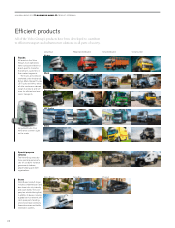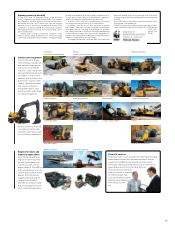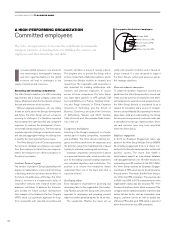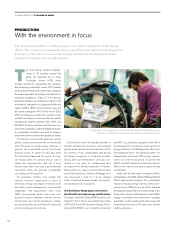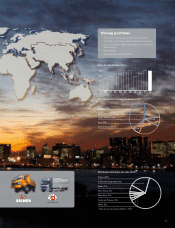Volvo 2012 Annual Report Download - page 38
Download and view the complete annual report
Please find page 38 of the 2012 Volvo annual report below. You can navigate through the pages in the report by either clicking on the pages listed below, or by using the keyword search tool below to find specific information within the annual report.
A GLOBAL GROUP 2012 BUSINESS MODEL
PRODUCTION
With the environment in focus
The environmental effort is and has long been one of the cornerstones of the Group’s
efforts. The common environmental policy is one of the most important documents for
governance. The policy is based on the Group’s environmental management system,
strategies and targets, reviews and measures.
he Volvo Group conducts manufac-
turing in 18 countries around the
globe. An important tool is Volvo
Production System (VPS), which
includes methods for streamlining the operation
and minimizing productivity losses. VPS includes
tools for documenting work-related risks, indicators
for measuring health and safety and methods for
ergonomic workplaces. Today, 17 of the Group's
production facilities are certified according to the
international standard for occupational health and
safety, OHSAS 18001. Environmental issues are
also partly managed in VPS. At the end of 2012,
97% of employees in production worked in units
certified according to environmental and quality
management systems, primarily ISO 14001 and
ISO 9001. At each production unit, there are envi-
ronmental coordinators, safety delegates and qual-
ity coordinators. Indicators are used to measure
and monitor work in environment, health and safety.
The Group’s environmental goals are used to
govern, develop and monitor the environmental
work. Focusing on energy-saving measures is
good for the environment and for the Group’s
financial results. A couple of years ago, when
the Volvo Group launched the world’s first car-
bon-neutral plant, the primary reason was to
reduce the environmental load, but it soon
became clear that it was also a good financial
investment, which will generate considerable
cost savings in the long-term.
All production facilities must comply with
common minimum requirements in terms of
chemicals, energy consumption, emissions to air
and water, waste management, environmental
organization and improvement work. Since
1989, environmental audits have been con-
ducted to ensure compliance with the environ-
mental policy and during acquisitions, compa-
nies and properties are reviewed with respect to
environmental aspects and risks.
In 2012, there were 15 licensable facilities in
Sweden. All have the necessary environmental
permits and no permit must be renewed in 2013.
An inventory of any contaminated land among
the Group’s properties is conducted annually.
During 2012, post-remediation work was con-
ducted on one case of contaminated land
among the Volvo Group’s properties in Sweden.
During 2012, one major environmental incident
occurred in Eskilstuna, Sweden. A leakage of oil
was discovered in time for it to be stopped
before it reached a nearby stream. No environ-
mental disputes are in progress.
The New River Valley plant is the first in
the US with two high energy certifications
The plant in New River Valley (NRV), which is the
largest for Volvo Trucks, was certified according
to ISO 50001 and SEP (Superior Energy Perfor-
mance). ISO 50001 is an international standard
An important tool in production is Volvo Production System (VPS), which includes
methods for streamlining the operation and minimizing productivity losses.
T
and SEP is a certification program in the US for
the development of continuous improvements in
energy efficiency. The NRV plant was SEP-certi-
fied at platinum level – the highest possible – for
implementing more than 15% energy improve-
ments over a three-year period. To achieve ISO
50001 and SEP standards entail a milestone for
NRV, on the way to becoming a carbon-dioxide
neutral plant.
Jointly with 32 other major companies, NRV is
participating in the DOE’s Better Buildings/Better
Plants improvement program. The commitment
includes reducing energy intensity, within a ten-
year period, by 25% per unit, and Volvo achieved
the program’s target within one year instead of ten.
Some of the solutions that helped to reduce NRV’s
energy consumption were technical, for example,
automation system, heating with solar energy and
infrared heat, and many of the ideas were contrib-
uted by employees.
34


